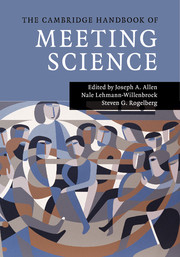Book contents
- The Cambridge Handbook of Meeting Science
- The Cambridge Handbook of Meeting Science
- Copyright page
- Dedication
- Contents
- Tables
- Figures
- Contributors
- Book part
- Part I Introduction
- Part II Premeeting Activities and Context
- Part III The Meeting Itself
- Part IV Special Types of Meetings
- Postevent Meetings
- Virtual Meetings
- Part V Synthesis and Conclusion
- Book part
- Author Index
- Subject Index
- References
Postevent Meetings
from Part IV - Special Types of Meetings
Published online by Cambridge University Press: 05 August 2015
- The Cambridge Handbook of Meeting Science
- The Cambridge Handbook of Meeting Science
- Copyright page
- Dedication
- Contents
- Tables
- Figures
- Contributors
- Book part
- Part I Introduction
- Part II Premeeting Activities and Context
- Part III The Meeting Itself
- Part IV Special Types of Meetings
- Postevent Meetings
- Virtual Meetings
- Part V Synthesis and Conclusion
- Book part
- Author Index
- Subject Index
- References
Summary
Debriefs are an effective tool for increasing learning and performance within organizations. They are regarded as “one of the most promising methods for accelerating learning from experience” (Eddy, Tannenbaum, & Mathieu, 2013, p. 976), and meta-analytic evidence supports their effectiveness (Tannenbaum & Cerasoli, 2013). Research also suggests that the success of a debrief is reliant on proper execution techniques. In this chapter, we identify and define debriefs and review scientifically supported strategies for achieving a well-executed debrief. Moreover, we present a table of recommendations based on this review of the debrief literature. Our intention is that these recommendations will serve as guidelines for the practical application of debriefs.
- Type
- Chapter
- Information
- The Cambridge Handbook of Meeting Science , pp. 615 - 660Publisher: Cambridge University PressPrint publication year: 2015

